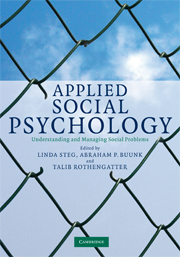Book contents
- Frontmatter
- Contents
- List of figures
- List of tables
- List of boxes
- List of contributors
- Acknowledgments
- 1 Introduction to applied social psychology
- 2 The USE of theory in applied social psychology
- 3 Applications of social psychology to increase the impact of behaviour-focused intervention
- 4 Research designs in applied social psychology
- 5 Social psychology and economic behaviour: heuristics and biases in decision making and judgement
- 6 Social psychology and immigration: relations between immigrants and host societies
- 7 Applying social psychology to the classroom
- 8 Social psychology and environmental problems
- 9 Gender issues in work and organizations
- 10 Social psychology of health and illness
- 11 Social psychology and mental health
- 12 Social psychology and modern organizations: balancing between innovativeness and comfort
- 13 Social psychology and the study of politics
- Index
- References
11 - Social psychology and mental health
- Frontmatter
- Contents
- List of figures
- List of tables
- List of boxes
- List of contributors
- Acknowledgments
- 1 Introduction to applied social psychology
- 2 The USE of theory in applied social psychology
- 3 Applications of social psychology to increase the impact of behaviour-focused intervention
- 4 Research designs in applied social psychology
- 5 Social psychology and economic behaviour: heuristics and biases in decision making and judgement
- 6 Social psychology and immigration: relations between immigrants and host societies
- 7 Applying social psychology to the classroom
- 8 Social psychology and environmental problems
- 9 Gender issues in work and organizations
- 10 Social psychology of health and illness
- 11 Social psychology and mental health
- 12 Social psychology and modern organizations: balancing between innovativeness and comfort
- 13 Social psychology and the study of politics
- Index
- References
Summary
Introduction
Mental health disorders represent one of the most common problems facing adults: within a twelve-month period nearly 30 per cent of the population experiences some diagnosable mental health disorder. Mental health disorders pose an enormous emotional burden for the individuals suffering from them, as well as an economic burden for society, especially in terms of the incapacity to work. For instance, in the year 2000 in England alone, the total cost of adult depression amounted to over £9 billion of which £370 million represent direct treatment costs and more than £8 billion represent costs due to lost working days. Clinical psychologists are concerned with analysing the causes of mental problems from which people may suffer, and with helping people to deal with such problems. Mental health problems are of interest to social psychologists as well. Mental health problems are to an important extent rooted in how individuals perceive their social world, and in how individuals function in their interpersonal relationships. For example, depressed people are often socially isolated, which makes current work in social psychology on the ‘need to belong’ directly relevant to understanding depression (Baumeister & Leary, 1995). It is, of course, not possible to describe everything that social psychologists do in the field of mental health in just one chapter. Therefore, this chapter focuses on three mental health problems: a disturbed body image, depression and relationship problems.
- Type
- Chapter
- Information
- Applied Social PsychologyUnderstanding and Managing Social Problems, pp. 249 - 270Publisher: Cambridge University PressPrint publication year: 2008

